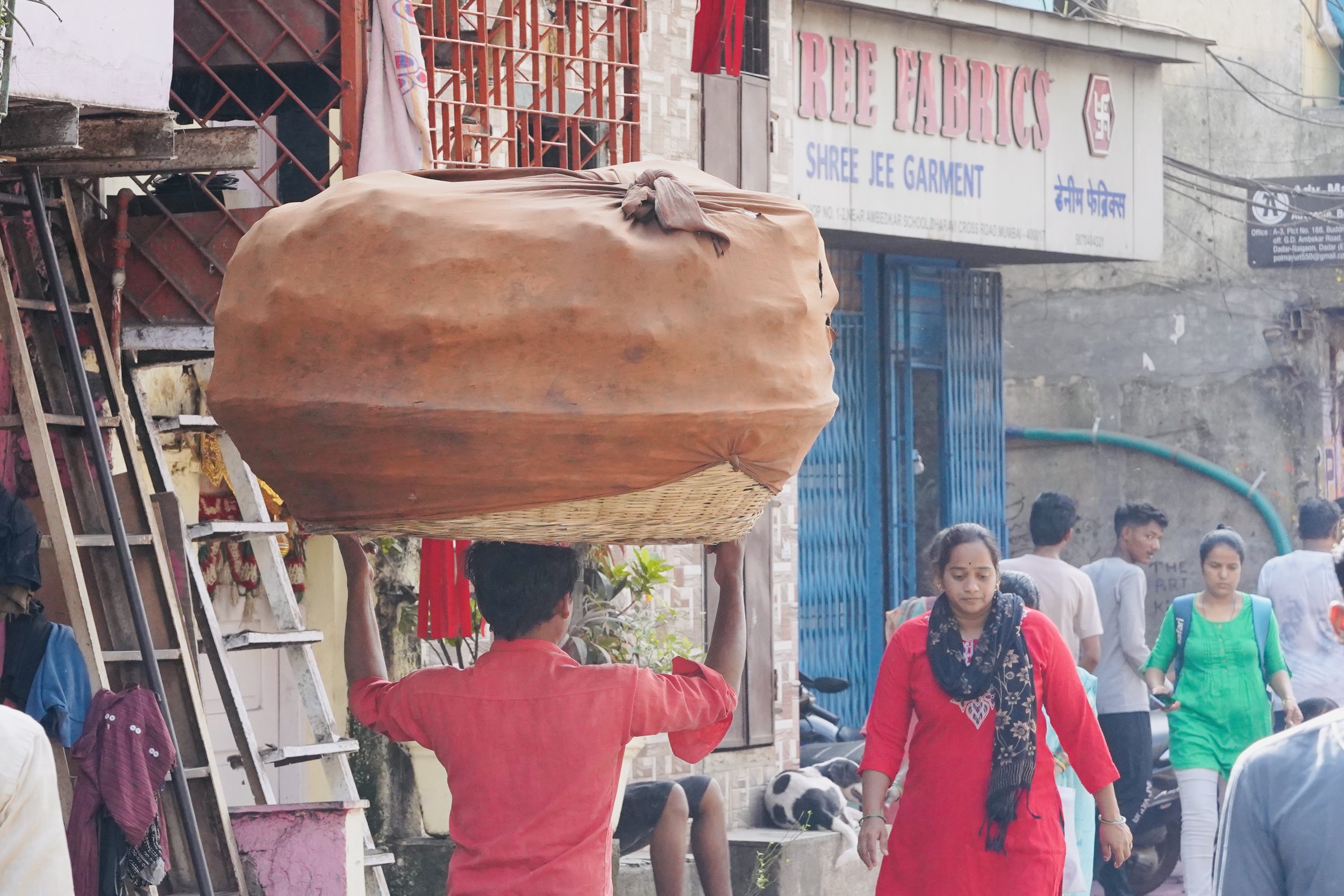Half-Day Mumbai and Slum Tour 孟买半日游与贫民窟之行
March 17, 2025
Our tour began from our hotel, Oberoi Hotel, with a drive along Marine Drive, the iconic boulevard known as the “Queen’s Necklace,” offering stunning views of the Arabian Sea.
Our first stop was Dhobi Ghat, the world’s largest open-air laundry, where hundreds of washermen (dhobis) hand-wash clothes for hotels, businesses, and individuals using traditional techniques and makeshift washing machines. Watching them work efficiently in this massive outdoor setup was fascinating.
Next, we visited the Gateway of India, a historic archway built during the British colonial era. Though under renovation, the waterfront remained bustling, with boats anchored offshore.
Driving through the city, we passed Chhatrapati Shivaji Maharaj Terminus (CST), a UNESCO-listed railway station with grand Victorian Gothic architecture, and Oval Maidan, where locals played cricket against the backdrop of the Rajabai Clock Tower.
Our next stop was Crawford Market, one of Mumbai’s oldest and most famous markets. After a brief walk through its bustling alleys, we headed to the Hanging Gardens on Malabar Hill. Lush and peaceful, the gardens offered a welcome escape from the city and provided sweeping views of Mumbai’s skyline and the Arabian Sea. What surprised us, however, was the guide’s explanation that the green, tree-covered area next to the garden is home to Mumbai’s famous Towers of Silence. Looking up, we noticed numerous vultures circling in the sky, a solemn reminder that the Parsi tradition of sky burials, practiced for over a thousand years, continues to this day.
Our final stop in the first half was Mani Bhavan Gandhi Museum, once Gandhi’s headquarters in Mumbai. The museum highlighted his life and contributions to India’s independence.
Afterward, our driver dropped us off at the tour company’s small office, where we had about 30 minutes before our slum tour began. We took the opportunity to relax at a nearby café, enjoying a latte and a chocolate croissant, before meeting our guide—a local who was born, raised, and still resides in Dharavi, Asia’s largest informal settlement.
Dharavi is often described as a slum, but stepping inside, we quickly realized it is far more than that. It is a bustling economic powerhouse, home to over two million people and countless small businesses. It also houses one of the world’s largest recycling industries, contributing significantly to Mumbai’s economy.
Walking through its narrow alleys, we saw workshops where artisans crafted leather goods, potters shaped clay, and recyclers processed discarded materials into something useful. Despite poor infrastructure and limited water supply, the resilience and resourcefulness of Dharavi’s residents were remarkable.
The tour left us with a deeper understanding of Mumbai’s contrasts—its wealth and struggles, tradition and progress, and the determination of its people.
孟买半日游与贫民窟之行
3月17日
昨晚飞到Mumbai ,接机的司机已经在机场门口等着我们。顺利入住酒店,终于可以好好休息。
今天我们的包车游从酒店门前的海滨大道(Marine Drive)开始。这条标志性的海滨大道被誉为“女王的项链”,沿途可欣赏到阿拉伯海的壮丽景色。
我们的第一站是塔塔洗衣场(Dhobi Ghat),世界上最大的露天洗衣场。成百上千的洗衣工(dhobis)在这里使用传统手洗技术或者简易洗衣机为酒店、商家和个人清洗衣物。在这片巨大的户外洗衣场中,他们工作场面令人惊叹。
接着,我们参观了印度之门(Gateway of India),这座历史悠久的拱门建于英国殖民时期。尽管正在维修,海滨仍然热闹非凡,水面上停泊着众多船只。
穿越城市,我们途经贾特拉帕蒂·希瓦吉终点站(Chhatrapati Shivaji Maharaj Terminus, CST),这座列入联合国教科文组织世界遗产的火车站,以宏伟的维多利亚哥特式建筑闻名。随后,我们经过椭圆广场(Oval Maidan),这里的草地上,当地人正在打板球,而背景则是宏伟的拉贾拜钟楼(Rajabai Clock Tower)。
下一站是克劳福德市场(Crawford Market),是孟买最古老、最著名的市场。在那里转了一圈,我们来到在马拉巴尔山(Malabar Hill)的悬空花园(Hanging Gardens),这里绿意盎然,环境幽静,可俯瞰孟买市区和阿拉伯海的壮观景色。有点出乎我们的意料的是导游介绍说花园隔壁那一片绿树覆盖的地方就是Mumbai出名的沉默之塔(Towers of Silence)所在地,抬头看见不远处天空上无数秃鹫在盘旋,帕西人千年以来为逝者进行天葬的传统沿续到今天。
上半部的最后一站是马尼·巴范甘地博物馆(Mani Bhavan Gandhi Museum),这座历史悠久的两层建筑曾是甘地在孟买的总部。馆内展示了甘地的生平事迹及其对印度独立运动的贡献。
随后,司机将我们送到旅行社的小办公室与后半段的导游见面。因为我们接下来的贫民窟之旅还有半小时才开始,在烈日下走了四个半小时的我们又饥又渴,于是就在旅行社附近的一家咖啡馆稍作休息,享用了美味的拿铁和巧克力可颂。
一位出生并仍然居住在达拉维贫民窟(Dharavi Slum)的当地向导带我们参观了亚洲最大的非正式住区之一,达拉维。
达拉维常被称为贫民窟,但当我们走进其中,才发现它远不止如此。这里是一个充满活力的经济中心,居住着超过两百万人,也是无数小企业的家园。这里还是全球最大的回收产业中心之一,对孟买经济有着重要贡献。
穿行在狭窄的巷道里,我们看到工坊里手艺人制作皮革制品,陶艺师捏制陶器,回收工人则将废弃材料重新加工,使其焕发新生。尽管基础设施有限,供水时间每天仅三小时,但这里的人们依然展现出惊人的韧性和创造力。
这次旅程让我们更加深入地理解了孟买的贫富对比与反差——它的繁华与困境、传统与现代,以及人们坚韧不拔的精神。









































